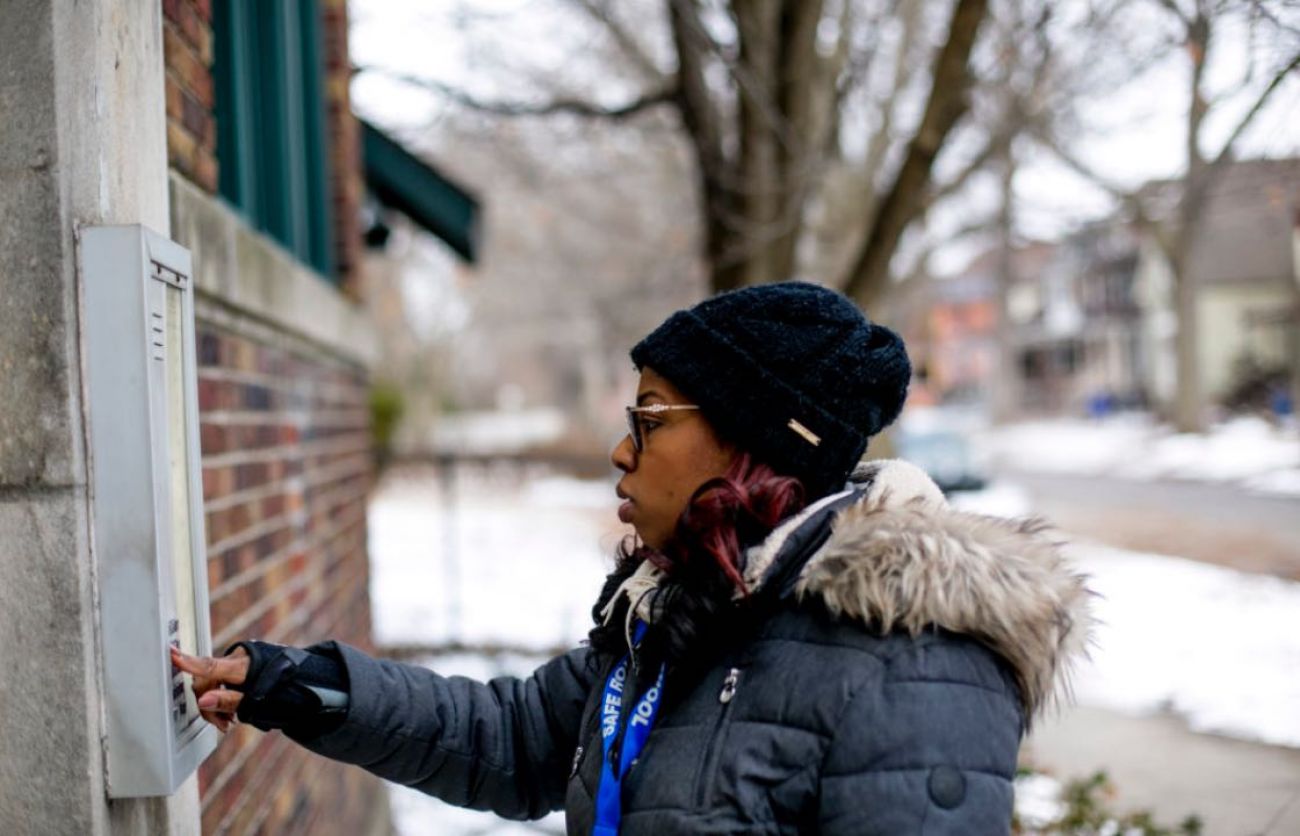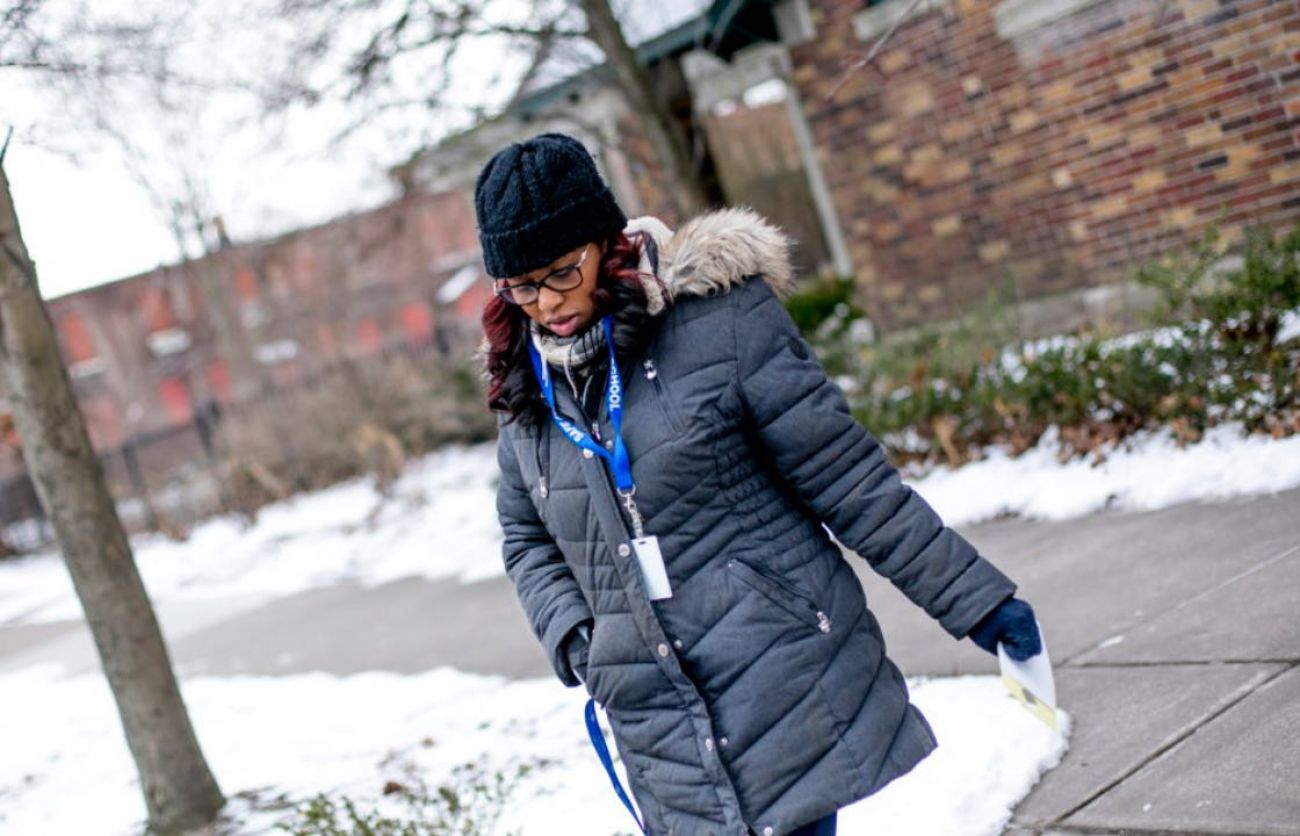In Detroit, going door-to-door to get students back in school

Editor’s note: This story was originally published in Chalkbeat Detroit in April 2019.
The little girl had missed 47 days of school before Amanda Bowman hopped into her white Jeep SUV to go find her.
Bowman, the attendance agent at Earhart Elementary-Middle School in Southwest Detroit, had been working with the third-grader’s family for weeks. She’d convened a meeting in early February with the family member who serves as the child’s guardian and gotten a promise that the girl would soon return to class.
But after a brief improvement, she disappeared again, missing another two weeks of school.
Bowman was right to worry. Children who miss that many school days can face devastating consequences as they fall behind in class. Some are already in crisis, struggling with personal or family issues that make it harder for them to arrive on time or in uniform.
And it’s Bowman’s job to help them.
She is part of the Detroit school district’s latest effort to tackle what has become one of its most intractable challenges — the fact most of its students are regularly missing class.
A stunning 70 percent of district students were labeled chronically absent during the last school year, meaning they missed 18 or more days of school. That’s one of the highest rates of chronic absence in the nation, and far above the state average of 20 percent.
As the district tries to remake itself after years at the bottom of nearly every national school ranking, this is one of the problems it most needs to fix. Otherwise, the district’s other reforms, such as a new curriculum, won’t have a chance to make much impact.
Community groups in Detroit have been working together to address chronic absence in the last few years, marshaling resources to bring attention to the issue. A pilot program last year in seven district schools, including Earhart, brought community groups together with school leaders to look for ways to help parents get their children to class.
But this year, the district made a much more significant investment, expanding that pilot to more schools, and spending $9 million to put an attendance agent like Bowman in nearly every one of its 106 schools.
Those efforts are allowing schools to go beyond simply enforcing the law that requires students to come to school.
Now, said Earhart Principal Melissa Villarreal, the focus is on figuring out what children need.
“Before it was us reaching out to the attendance agent [in the central office] when we had severe cases,” Villarreal said. “Now the whole focus is more preventative. We try to get to the students before it becomes severe … They need to understand and believe that we’re not here to judge. We’re not here to call protective services. We’re here to help.”

Frequent absences are often a strong indicator that children and their families need support.
“Maybe they don’t have access to appropriate health care or they’re experiencing trauma or transportation challenges or a lack of access to stable food and shelter,” said Hedy Chang, who runs Attendance Works, a national organization that helps schools improve attendance.
Last year, when only about a quarter of the district’s schools had in-house attendance agents, most schools had to share a team of 18 agents, based in the central office, who triaged requests from across the city.
Now, with attendance agents like Bowman in nearly every school, there’s a dedicated person who can study daily attendance reports and analyze data in search of students who might need help.
That leads to solutions such as when Bowman discovered recently that a student was having trouble getting a ride to school. She and Villarreal helped connect him with the school’s PTA president who lived nearby and offered to pick him up every morning on her way to school with her own children.
“Since then, he’s been to school pretty much every day,” Bowman said of the formerly absent student.
Bowman puts time into rewarding good attendance, bestowing popcorn or a chance to come to school out of uniform to the class with the best attendance each month. She’s planning a raffle this spring in which middle schoolers with 45 days of perfect attendance can vie for prizes, like a Nintendo Switch, that were paid for with a grant from a community group

A new “donuts with the deans” program honors students whose attendance has improved. She’s taken steps to cut down on students coming late to school, implementing a policy that requires students who don’t walk through the door by the 7:30 a.m. bell to stand in line to get a tardy pass.
And when she does need to go knock on a student’s door, the theory is, she’ll be more welcome than the unfamiliar truancy officers who might have gone knocking in the past.
Familiarity is especially important in schools like Earhart where some students have undocumented immigrants in their families and might worry that a stranger at the door is connected to immigration authorities. Instead, the district wants families to see agents as allies.
“It’s an opportunity to connect with families, to let them see the concern that you have for what’s happening with the child,” said Iranetta Wright, the district’s deputy superintendent. “It’s a voice from the school saying ‘We haven’t seen your child. We want to see your child. What can we do to help?’ It changes the conversation completely.”
That’s the theory anyway. The reality can be a bit more complicated, as Bowman experienced on a cold morning in early March when she went looking for the missing third-grader.
Before leaving the school that morning, she’d eyeballed the girl’s house on Google Street View to get a sense of the neighborhood. “It lets me know what the environment kind of looks like and what I should be looking for,” she said.
She parked her car in front of the neat brick house where the third-grader lives and began to assess her surroundings, carefully looking up and down the street for threats.
“I listen for dogs,” she said before stepping onto the porch of the girl’s house.
She rang the bell, then waited.
She knocked, gently.
“I don’t want to make a police knock,” she said later. “I don’t want someone to come to the door with a gun.”
If the door had opened, Bowman was ready with a speech about ways the school could support the family to improve attendance. But although she spotted a family member on the other side of the door, trying to peek out without being seen, the door remained solidly shut.
“He saw my badge and decided not to open the door,” she said. “That means they know they’re in the wrong and they’ll probably show up with her tomorrow.”
Instead of delivering her speech, Bowman left a notice on the door that spells out the legal implications of missing school.
“If you continue to ignore your parental responsibility,” the letter states, “you will be prosecuted for educational neglect which may involve a penalty and imprisonment for not less than two days or more than ninety days.”
Bowman then headed to another address on her list.
She got no answer at the next house either. A third address she hoped to visit turned out to be an apartment building for which she had no apartment number.

It’s not unusual for a day of home visits like this to turn up empty.
“This is what I’m up against every day,” Kirk Peterson, the attendance agent at Greenfield Union Elementary-Middle School, said one day after a morning knock on the door of a home on Cardoni Street that was clearly vacant. “So now I’ve got to go find out where this family actually lives.”
Earlier that morning, Peterson had tried unsuccessfully to track down another chronically absent child who lived near the school not far from Detroit’s northern border. But as he slowed to a stop in front of the home on Annin Street, he spotted a problem: There was no porch. That meant he’d need a backup agent, per district policy, in order to knock on the back door.
“Oh my God,” he said. “We can’t go up there.”
These were the only two stops Peterson had scheduled that morning. On other days, though, he can do as many as a dozen or more. Always, in a handful of cases, he encounters an empty lot, a vacant house, or an outdated address — enduring features of Detroit’s recent struggles with foreclosure, arson, and blight.
Some children are never found — a frightening notion in a city that was shaken in 2015 when two children who had been missing from school were found dead in their mother’s freezer. The mother is now serving a life sentence for their murder.
Other times, agents find the children but can’t get through to them or their families.
Peterson said some parents offer excuses about why they can’t get their children to school.
“It’s really unexplainable,” Peterson said. “I really don’t understand why we have some parents that don’t look at it from the perspective of wanting their children to have a better life than they had.”
Though there are plenty of dispiriting days, Bowman and Peterson say they’ve also seen how home visits can work. Peterson nixed one of his planned stops one morning because the child in question had shown up for school that day — after he’d left a note on a previous visit to the home.
Bowman recalled a father she visited recently who refused to open the door for her when she rang his bell, but then immediately started sending his three children to school after her visit.
“It was like a snap of the finger,” she said. “They just started coming to school and they have been here pretty much every day since I did the home visit.”
But the home visits are a last resort, Bowman said. She sees her job as helping children enough that home visits won’t be necessary.
That’s not an easy proposition. Earhart still has an alarmingly high chronic absence rate: 55 percent of the school’s 860 students had missed at least 10 percent of the class days as of last month. That includes 158 students who had missed at least 20 percent of classes.
But there have been improvements. Nearly 150 students had perfect attendance in January and February, up from 85 who had perfect attendance in November and December.

Across the district, Superintendent Nikolai Vitti noted at the March school board meeting that daily attendance rates are up. A good indication: The district had had only two days this school year where attendance dipped below 75 percent. At the same time last year, he said, there were eight days where the rate was below 75 percent.
He said he’s also seeing the chronic absence rate dropping across district, though it’s too soon to tell whether his increased investment in attendance will pay off with a lower rate for the school year. Typically, attendance drops as summer vacation approaches.
“In no way have we arrived,” he said.
Community groups, the United Way for Southeastern Michigan, and the Skillman Foundation (which is a Chalkbeat funder), are continuing to invest in attendance efforts through their Every School Day Counts initiative. The initiative has staff, including attendance agents and deans at 27 of the district’s most struggling schools meeting regularly to share ideas and best practices across schools.
The effort is also bringing some best practices, including weekly attendance meetings and staff training sessions to 10 charter schools.
The participating charter schools don’t necessarily have full time attendance agents but Chang, from Attendance Works, says attendance needs to be the work of the entire school, including parents and the surrounding community.
“If you just have one person who’s responsible for going and doing home visits, they can only reach so many kids,” Chang said. “Especially if you’re talking about schools where more than half of the kids in the district are chronically absent … You need to enlist the entire school.”
Across the country, Chang said, some schools have discovered that they need to make their schools more inviting. Others have found that students need food or clean clothes or help with responding to bullies.
Addressing those needs should be a community effort, said Terry Whitfield, a program officer for Skillman, which has been awarding $3,000 grants that eligible schools can use to buy things like washing machines.
“When it works well, you create a culture of responsibility when it comes to attendance,” Whitfield said. “Everybody is taking ownership of creating a school-going culture so that, from the front office staff to the custodian to the teachers … there’s an understanding that our students need more attention when it comes to attendance.”
At Earhart, a group called Urban Neighborhood Initiatives attends school attendance meetings looking for ways that the community can support attendance in the school. The group contributed $1,000 to, among other things, pay for the prizes Bowman will hand out to students who win the perfect attendance raffle. The organization is also hosting an after-school program, starting this month, that aims to lure middle schoolers to class by allowing them to take cooking and art classes after school.
That kind of work might not be as dramatic as knocking on a door and leaving a legal notice, said Villarreal, but it shows families that the school can be a resource.
“It’s teaching ourselves to be humble and kind and modeling that to the parents that we’re not here to judge you. We’re not here to get you,” Villarreal said. “Once you build that relationship and you bond with those families, they open up, they start to present their real scenarios.”

Michigan Education Watch
Michigan Education Watch is made possible by generous financial support from:
Subscribe to Michigan Education Watch
See what new members are saying about why they donated to Bridge Michigan:
- “In order for this information to be accurate and unbiased it must be underwritten by its readers, not by special interests.” - Larry S.
- “Not many other media sources report on the topics Bridge does.” - Susan B.
- “Your journalism is outstanding and rare these days.” - Mark S.
If you want to ensure the future of nonpartisan, nonprofit Michigan journalism, please become a member today. You, too, will be asked why you donated and maybe we'll feature your quote next time!






